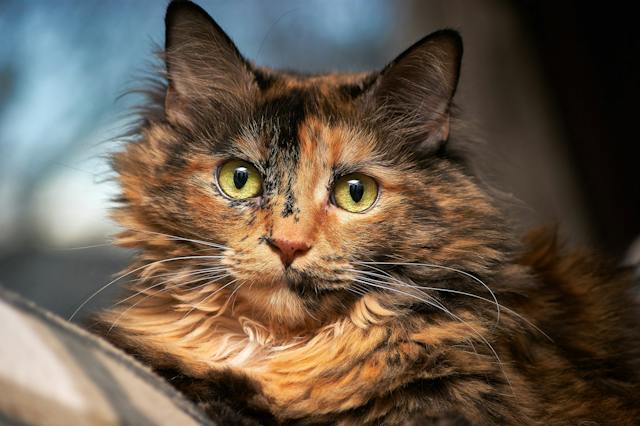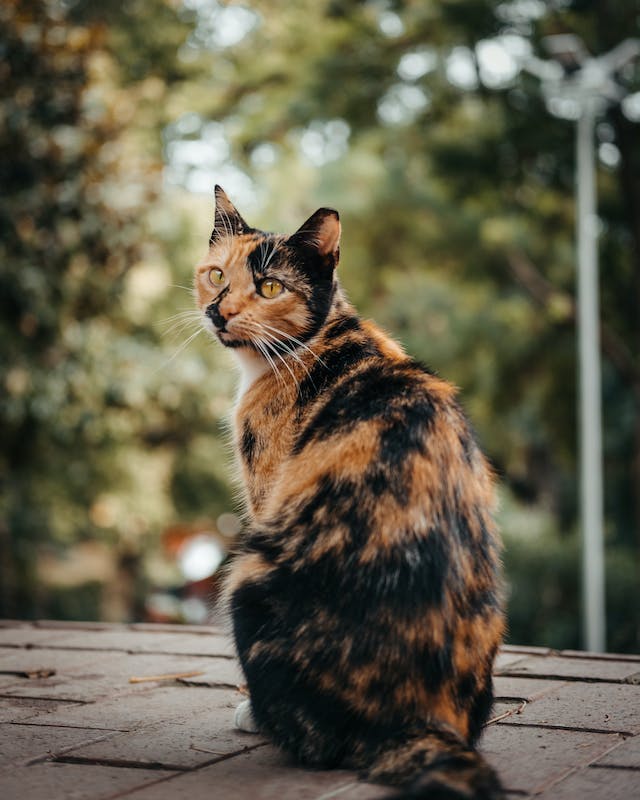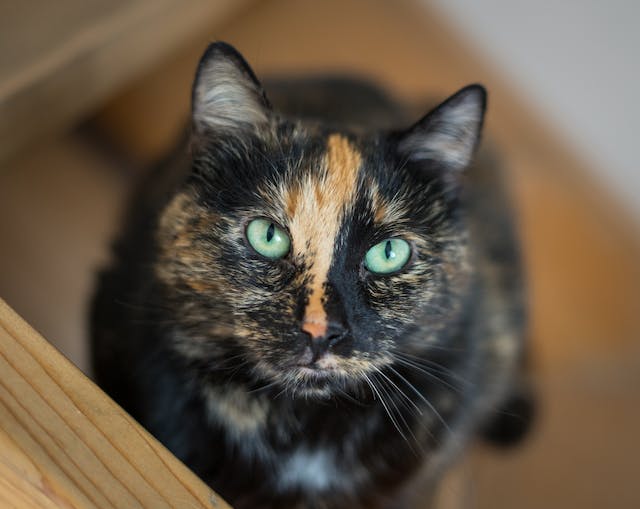Tortoiseshell Cat Lifespan and Care Tips
Posted: 11/17/2023 | BY: Jenna Bruce | Categories: Cat , Pet care , Top Tips
Tortoiseshell cats are some of the most beautiful in the world. In fact, the name refers to the unique colorings and markings of the cat, not actually a separate cat breed. If you are lucky enough to share your life and home with one of these beauties, you most likely want to know the Tortoiseshell cat lifespan.
In this article we’ll dive into the life expectancy of Tortoiseshell cats as well as what you can do to ensure your fur baby lives a long and healthy life.

What’s the Average Lifespan of a Tortoiseshell Cat?
We all want to spend as many years as possible with our fur babies. Luckily for Tortoiseshell cat parents, these cats have an average life expectancy of between 12 and 14 years.
While genetics does play a role in life expectancy, lifestyle has even more of an impact. That’s great news because it means there are things you as a parent can do to extend your cat’s life. That’s why some cats live until 12 and others live until 22. It’s really not just luck but how you care for your fur baby!
How to Extend Your Tortoiseshell Cat’s Lifespan
The following guidelines will help you ensure your cat lives their very best – and longest – life!
Choose a Reputable Breeder
If you decide to get your fur baby from a breeder, make sure they are reputable. Good breeders make sure their kittens come from a healthy lineage. They also test for any potential genetic issues, deworm the litter, and begin the kittens’ vaccination schedule. This ensures you get a healthy cat with the potential to live a long life.
Regular Wellness Checkups
Keeping your cat healthy means getting them to the vet for regular checkups. This is particularly true as your cat ages. One yearly examination is fine when cats are young, but once they become a senior, it’s recommended they be seen twice a year. This is because cats are stoic and tend to hide pain. Theymay seem healthy but in the background they have a health issue brewing. The sooner any condition is caught, diagnosed and treated, the better the health outcome (and the longer your kitty lives!)
Help Them Drink More Water
Some cats just don’t drink enough water. To make matters worse, many cats are prone to developing chronic kidney disease as they age. Proper hydration is one way to decrease the odds of kidney disease.

If your Tortoiseshell does not drink enough and you have water in a bowl, consider getting a water fountain. Many cats do not like stagnant water but will happily lap up running water. So try a fountain or leave one of your taps dripping for them. If your cat eats a mostly dry kibble diet, consider switching over to a wet food diet to help them get more water. As always, speak to your vet before making any dietary changes.
Which brings us to our next guideline…
Provide an Optimal Diet
Hands down diet is one of the most important things for health and longevity. Sadly, many cat foods on the market today are anything but optimal when it comes to nutrition. A majority have fillers like corn or soy and only offer the very minimal nutrition required by regulatory guidelines.
Luckily there are more and more organic, wholesome foods coming onto the market that do offer optimal nutrition. Speak with your vet to see which foods they feel are ideal for your cat’s health.
Spay or Neuter
We all know spaying and neutering is important to tackle the pet overpopulation problem we have in this country. But did you know spaying or neutering your cat can actually help to extend their life?
According to a study by Banfield Pet Hospitals, spayed female cats live an average of 39% longer while neutered male cats live an average of 62% longer.
It turns out these surgeries reduce your cat’s chance of developing certain cancers of the reproductive organs. They also keep intact pets from trying to escape the home and roam the streets in search of a mating partner. This is how many pets wind up lost and injured.

Optimal Dental Care
Good dental hygiene is not just important to your cat’s mouth but to their overall health as well. When teeth and gums become infected, they can lead to significant pain and tooth loss. In addition, the bacterial infection can spread, getting into the bloodstream where it travels and damages organs like the liver, kidneys and even heart.
It’s important to take your fur ball in for regular dental checkups and professional cleanings. Equally important is taking care of your cat’s teeth and gums at home. Ask your vet to show you how to brush your cat’s teeth in between professional cleanings. (never use human toothpaste as it is very toxic to pets). If your cat just won’t let you brush her teeth, be sure to offer her plenty of dental treats to help keep her teeth clean.
Pet Insurance
According to MetLife insurance, 1 out of 3 pets requires emergency medical care each year. Keep in mind, many of these emergency vet bills run in the thousands of dollars.
Are you financially prepared to pay for the cost of emergency care that can save and extend your cat’s life?
Many pet parents are turning to a pet insurance plan to help them pay for treatments. A plan for a young cat can cost as low as $10 a month. Spend a bit more and get a plan that will reimburse you for up to 90% of the vet bill. That gives your fur baby the care they need and you peace of mind.
Here are the top providers based on reviews from pet parents just like you:
Top Pet Insurance Providers of 2025
| Rating | Provider | Total Review |
|---|---|---|
| 4.9 | Embrace | 18,435 |
| 4.9 | Healthy Paws | 10,195 |
| 4.9 | Trupanion | 60,921 |
| 4.9 | Fetch | 26,338 |
| 4.9 | Lemonade | 809 |
| 4.8 | Nationwide | 21,411 |
| 4.8 | Prudent Pet | 1,796 |
| 4.7 | Pumpkin | 1,687 |
| 4.6 | Hartville | 170 |
| 4.6 | ManyPets | 2,381 |
| 4.6 | Spot | 8,042 |
| 4.5 | ASPCA | 11,880 |
| 4.5 | PetPartners | 115 |
| 4.4 | AKC | 893 |
| 4.3 | Pets Best | 12,928 |
| 4.2 | Figo | 2,618 |
| 4.0 | Pet Assure | 13 |
| 3.9 | MetLife | 736 |
Final Thoughts
As you can see, the Tortoiseshell cat lifespan is based more on lifestyle than genetics. If you follow these guidelines you can ensure you have many, many years with your fur baby.
References:
- https://www.humanesociety.org/resources/why-you-should-spayneuter-your-pet
- https://www.humanesociety.org/sites/default/files/docs/Banfield-State-of-Pet-Health-Report_2013.pdf
- https://www.metlifepetinsurance.com/blog/pet-health/6-shocking-pet-health-statistics/
Disclaimer
The information contained on this blog is intended for informational and educational purposes only and should not be construed as medical advice. It is not a substitute for professional veterinary care. Always consult with your veterinarian before making any changes to your pet's health care or treatment plan.
The authors of this blog are not veterinarians and do not claim to be experts in pet health. The information provided here is based on our own experiences and research, as well as information from reputable sources. However, we cannot guarantee the accuracy or completeness of this information.
We encourage you to do your own research and consult with your veterinarian before making any decisions about your pet's health.
Previous post
Burmese Cat Lifespan and Care TipsCompare top pet insurance providers & plans.
Enter your dog’s age in years and months to calculate their age equivalent to human years.
Calculate your dog’s ageEnter your cat’s age in years and months to calculate their age equivalent to human years.
Calculate your cat’s age